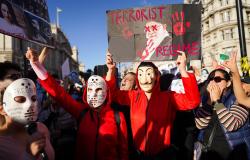Iran Protests: Positive Change on the Way?

Marzieh Kouhi Esfahani argues that Iran's way out of the current protests are hampered by the absence of competent elite. This is the third in a four-part series following an event exploring these developments held at the Institute for the Middle East & Islamic Studies at Durham University.
Following the death of Mahsa Amini in moral police’s custody, Iran’s most recent round of protests went over days and months and across numerous cities and towns. The magnitude and extent of the protests led to an important question; will the Islamic Republic give in to public demand for applying significant change? This essay will argue the unlikeliness of any significant appeasement steps by the Islamic Republic and will make an attempt for explaining the reasons.
The Story So far…..
Three months after the start of the new round of protests, despite the scope and magnitude of criticisms and protests, the most significant response has been heavy crack down on protestors. Killing and injuring protestors by rubber bullets and live rounds was followed by record number of arrests and harsh sentences including death penalties for those who have been accused of rioting. While Tehran streets have not witnessed the so-called morality police in recent weeks, reportedly, business has been as usual in other cities, with claims of increased surveillance. Various hard liners have emphasized that the compulsory hijab law is not retractable while also proposing less direct means of coercing women into compliance, such as depriving them of particular public services. While in the early hours and days the protests were against police enforced mandatory hijab and the appalling treatment of women, the heavy crackdown radicalised the situation towards calls for regime change, at times in an exceptionally offensive language towards the supreme leader.
 So, why doesn’t the Islamic Republic resort to accommodate some public demands to calm the situation down peacefully and increase its legitimacy? The following discussion will argue the reason to be the absence of necessary capacity to create any positive, meaningful and lasting change.
So, why doesn’t the Islamic Republic resort to accommodate some public demands to calm the situation down peacefully and increase its legitimacy? The following discussion will argue the reason to be the absence of necessary capacity to create any positive, meaningful and lasting change.
-
Lack of mutual understanding
One aspect of this multifaceted problem is comprehension, with the authorities failing to understand the grievances and demands of protestors. The system is so obsolete vis-a’- vis its people, their demands, and aspirations, that neither side can understand the other. Though speaking the same language, the regime’s discourse and that of its agents is so far from the people, especially younger generations, that they do not recognise each other’s perspective.
There is no mutual understanding between the Islamic Republic’s old, rigid minded radical leaders and the vibrant, cosmopolitan, Z generation who get much of their world views and values from the social media and their international network of friends and followers. These youth feel increasingly alienated by the ideologically driven values, and the lifestyle that is constantly propagated and forced on them by the system through various means.
This lack of mutual understanding is best manifested in what Zarghami, Iran’s Minister of Cultural Heritage and Tourism narrated from a dialogue he had with an experienced interrogator/cross examiner who told him, “I have interrogated many important political figures in my years. However, the interrogations I carried out in the past few weeks were the hardest. I interrogated hundreds of people who did not understand me, and I did not understand them either.”
-
System-wide fear of change
Close to home historical precedents have created the system-wide perception that even one step retreat or any small opening would see the Islamic Republic’s end. Examples include the last Shah of Iran creating minor reform less than two years before his demise under the international pressure spearheaded by the Carter administration. Another example is the Soviet Union’s Glasnost and Perestroika, which subsequently led to the collapse of the Soviet Union.
A more realistic reason for this fear, is the regime’s awareness of the importance of symbolic manifestations of ‘being Islamic’ to maintain its hardcore ideological supporters. With the failure to fulfil the promises of the 1979 revolution such as eradication of poverty and inequality, or creation of a truly fair Islamic society, symbolic manifestations such as the hijab and anti-Imperialism are one significant rope holding supporters together and around the regime. Letting go of these symbols means losing this remaining hard core, ready to fight supporters.
-
Unit level fear of change
The old divisions of Islamic Republic’s main political factions of reformism and conservatism is largely outdated, in today’s Iran. Each faction, especially the conservatives have splintered into several rival, mafia style/sponsored subgroups. This means the rivalry and conflicts are mostly among different conservative groups, involving, especially, various parts of the security apparatus. The more serious and urgent the issue of the supreme leader’s succession has become, the more ruthless the rivalry between these mafias and splinter groups has developed into. In such atmosphere, the winner of the ordinary supporters is the one who demonstrates a firmer stance on the so called ‘revolutionary’ values. Any flexibility and giving in to the demands of the perceived ‘Westoxified, non-revolutionary’ others, means losing status, accompanied power and privileges to rival mafias.
Given the above three factors, the likelihood of a constructive and fruitful dialogue within the regime is not significant. Continuous harsh messages and accusations from various platforms which at times work as petrol on fire, and frequent contradictory statements by various political figures, reflects too big a chasm to make such dialogue within the regime, in its broader sense, possible.
-
Absolute lack of capacity
Assuming the above hurdles have somehow been resolved, and lead to a productive dialogue within the system for peaceful diffusion of the situation, there is then the question of who and how.
In addition to the impact of the fierce sub-factional rivalry explained above, on this stage, lack of both theoretical and practical competency is another significant hurdle.
As the circle of ‘us’ (as oppose to ‘them’) has become smaller and smaller over the years, the system has been drained from competent clear-headed strategists and executives who have the ability, the valour as well as the public’s trust to figure a way out of this dire situation and carry that out with minimum damage and cost.
The competent, clearheaded specialists in various fields have either left the country providing Iran with a top seat at the brain drain world table, been imprisoned or have been deprived of impactful positions. This has galvanised the system against any positive meaningful change. Further securitisation of the environment and rampant accusations towards any accommodationist approach would cost any remaining competent individual too dearly to dare.
To sum up all these factors in a concise picture, we have a state at odds with the society, which is not only incapable of understanding its people and their demands, but is half paralysed by too much fragmentation and rivalry within the system. This complicated situation is further doomed by the stalemate resulting from the absence of competent elite at the decision-making level, and bureaucrats or a mature and effective civil society at the executive level, presenting a bleak perspective for Iran’s future.
Part 1 - From Dissatisfaction to Mobilisation: The Islamic Republic’s Perfect Storm
Part 2 - The Iranian Protests: Change may not be immediate but is inevitable
Dr Marzieh Kouhi Esfahani is an Assistant Professor of Politics and International Relations of the Middle East in the School of Government and International Affairs at Durham University. Among her publications is Iran and Political realism in Edinburgh Companion to Political Realism (Edinburgh University Press 2018).
Image: Alisdare Hickson via Flickr (CC BY-SA 2.0)


